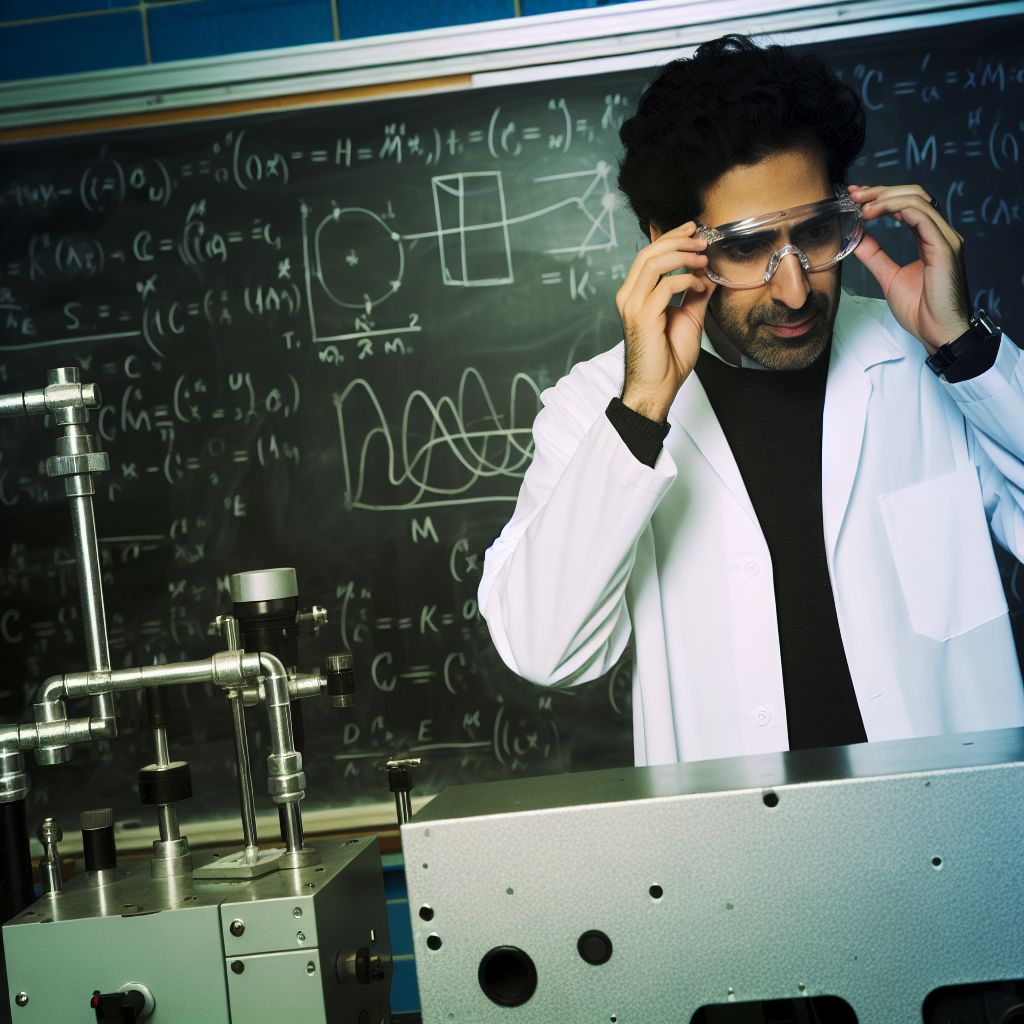Emerging Technologies in Physics: Quantum Computing and Its Impact on Careers
Introduction to Quantum Computing
Quantum computing represents a significant leap in computational power.
This technology utilizes the principles of quantum mechanics.
As a result, it can solve complex problems much faster than classical computers.
Many sectors, including physics, are exploring its potential applications.
Impact on Physics Research
Quantum computing is transforming research methodologies in physics.
It allows scientists to model complex quantum systems with greater accuracy.
Such advancements enhance our understanding of fundamental physical laws.
Moreover, it encourages collaboration across interdisciplinary fields.
Career Opportunities in Quantum Computing
The rise of quantum computing creates numerous career paths.
Professionals can work in academia, industry, or government sectors.
Job roles include quantum software developers and researchers.
Additionally, opportunities exist in quantum communication and cryptography.
Thus, physics graduates must adapt and develop relevant skills.
Essential Skills for Future Physicists
To thrive in quantum computing, physicists need to acquire specific skills.
- Strong mathematical and analytical abilities are crucial.
- Programming skills in languages like Python or C++ are essential.
- Familiarity with quantum mechanics and computer science is beneficial.
- Moreover, teamwork and communication skills enhance collaborative efforts.
Education and Training Pathways
Those interested in quantum computing should explore various education pathways.
Many universities now offer specialized programs in quantum physics and computing.
Additionally, online courses provide flexible learning options.
Internships can also offer practical experience in real-world applications.
The Future of Physics Careers
As quantum computing evolves, so will career opportunities in physics.
Continued advancements may lead to new fields of study and research.
Staying informed about emerging technologies is vital for career growth.
Ultimately, embracing change will position physicists for success.
The Role of Artificial Intelligence in Advancing Physics Research and Applications
Enhancing Data Analysis
Artificial Intelligence significantly improves data analysis in physics research.
It efficiently processes large data sets generated by experiments.
For instance, Machine Learning algorithms identify patterns in particle physics data.
Unlock Your Career Potential
Visualize a clear path to success with our tailored Career Consulting service. Personalized insights in just 1-3 days.
Get StartedAdditionally, AI tools streamline data extraction from complex simulations.
Moreover, researchers can focus on more profound questions rather than tedious calculations.
Optimizing Experimentation
AI optimizes experimental designs in physics.
It predicts outcomes based on previous experiments, saving time and resources.
This predictive capability enhances the success rate of experiments.
Furthermore, AI helps determine the best conditions for conducting new experiments.
Thus, it accelerates the pace of innovation in various physics fields.
Advancing Theoretical Physics
Artificial Intelligence also impacts theoretical physics significantly.
AI models assist researchers in generating new theories efficiently.
For example, neural networks explore complex quantum systems.
Moreover, these AI-driven models can release theoretical frameworks previously neglected.
Consequently, they broaden the scope of inquiry and innovation in the field.
Facilitating Interdisciplinary Collaboration
AI fosters collaboration among diverse scientific disciplines.
Physics researchers benefit immensely from insights from fields like biology or computer science.
For instance, AI applications in biology are spurring innovations in biophysics.
This collaboration enriches physics research with new methodologies and perspectives.
Ultimately, it enhances the ability to tackle complex global challenges.
Transforming Education and Training
Artificial Intelligence transforms physics education and training.
AI-driven platforms provide personalized learning experiences for students.
These platforms adapt to individual learning styles and paces effectively.
In addition, AI tools assist educators in developing engaging content.
By utilizing AI, educational institutions can better prepare future physicists.
Sustainability in Physics: Career Opportunities in Renewable Energy Innovations
The Growing Importance of Renewable Energy
Sustainability has become a key focus in global energy discussions.
Countries are aiming to reduce their carbon footprints significantly.
As a result, renewable energy sources are gaining traction.
Physicists play an essential role in advancing these technologies.
Career Pathways in Renewable Energy
Numerous career opportunities exist within the renewable energy sector.
One possibility is working in solar energy research and development.
Researchers in this area enhance technology efficiency and affordability.
Wind energy technology also offers diverse career options.
Roles in this field focus on turbine design and resource assessment.
Emerging Fields in Sustainable Physics
New fields continue to emerge in sustainable physics.
Energy storage technologies present exciting career prospects.
Experts are exploring advanced battery technologies and supercapacitors.
Additionally, smart grid technology integration relies on physicists’ expertise.
This area ensures efficient energy distribution across networks.
Educational Requirements and Skills
A career in renewable energy often requires specialized education.
A solid foundation in physics and engineering is essential.
Additionally, knowledge of environmental science complements these skills.
Hands-on experience through internships can significantly enhance employability.
Organizations Leading the Charge
Many organizations drive innovations in the renewable energy sector.
One prominent company is EnerTech Solutions.
They focus on developing cutting-edge solar technologies.
Moreover, GreenWind Innovations specializes in wind turbine advancements.
These organizations offer robust career opportunities for physicists.
Networking and Professional Development
Networking in this field can be incredibly beneficial.
Attending renewable energy conferences often leads to valuable connections.
Professional organizations, such as the American Solar Energy Society, are worth joining.
Such memberships provide access to resources and job opportunities.
See Related Content: Popular Workplaces for Ecologists in Canada
Interdisciplinary Approaches: Combining Physics with Biology and Medicine
The Importance of Interdisciplinary Collaboration
Interdisciplinary collaboration plays a crucial role in modern science.
Bringing together physics, biology, and medicine opens new avenues for innovation.
This collaboration enhances our understanding of complex biological systems.
As a result, it facilitates the development of advanced medical technologies.
Applications of Physics in Medicine
Physics principles are vital in medical imaging technologies.
For example, MRI and CT scans rely heavily on physics concepts.
Furthermore, radiation therapy uses physics to target tumors effectively.
These applications improve diagnostic accuracy and treatment outcomes.
Biophysics: A Growing Field
Biophysics merges biological research with physics methodologies.
This field examines biological processes at a molecular level.
Researchers use biophysical techniques to study protein interactions.
Additionally, they investigate the biomechanics of cellular functions.
Such insights lead to more effective therapeutic strategies.
Future Innovations Driven by Interdisciplinary Research
Future innovations will likely stem from interdisciplinary research initiatives.
For instance, the development of personalized medicine depends on these collaborations.
Combining big data with physics can enhance disease prediction models.
Moreover, quantum computing may revolutionize drug discovery processes.
These advancements showcase the importance of integrating diverse scientific disciplines.
Preparing the Workforce for Interdisciplinary Careers
Educational institutions must adapt curricula to prepare students for interdisciplinary careers.
Offering joint programs in physics, biology, and medicine is essential.
Such programs will equip students with diverse skill sets.
Furthermore, internships in multidisciplinary research settings enhance real-world experience.
Ultimately, a well-prepared workforce will drive future innovations.
Explore Further: How Epidemiologists Use Data to Save Lives
The Future of Space Exploration: Careers in Astrophysics and Aerospace Engineering
Emerging Opportunities in Astrophysics
Astrophysics is rapidly evolving with new technologies.
Researchers focus on understanding the universe’s mysteries.
Career prospects in this field are expanding significantly.
Innovations in telescopes and observational methods drive this growth.
Jobs in data analysis and computational astrophysics are increasing.
Many organizations seek to uncover dark matter and dark energy.
Collaboration with international space agencies enhances research opportunities.
Advancements in Aerospace Engineering
Aerospace engineering is booming due to the commercial space race.
This sector demands skilled engineers for spacecraft design and manufacturing.
Companies like Blue Origin and SpaceX are leading this revolution.
They offer exciting career roles in spacecraft systems and propulsion.
Moreover, advancements in sustainable aviation technologies are crucial.
Engineers now focus on reducing greenhouse gas emissions.
The development of electric and hybrid aircraft is a priority.
Education and Skills Required
Pursuing a career in these fields requires a strong educational background.
A bachelor’s degree in physics or engineering is essential.
Advanced degrees often open more career opportunities.
Skills in programming and data analysis are highly valued.
Furthermore, experience with simulation software can set candidates apart.
Internships with research institutions or aerospace companies provide practical experience.
The Role of Interdisciplinary Knowledge
Astrophysics and aerospace engineering complement each other effectively.
Skills from both fields enhance problem-solving capabilities.
For example, engineers apply physics principles to design spacecraft.
Similarly, astrophysicists utilize engineering skills for observational equipment.
Interdisciplinary collaboration is key to advancing space exploration.
It fosters innovation and drives breakthroughs in technology.
Networking and Professional Organizations
Networking is crucial for career advancement in these fields.
Professional organizations like the American Astronomical Society offer resources.
These organizations provide platforms for sharing research and ideas.
Conferences and workshops help professionals connect and collaborate.
They also feature presentations on the latest research developments.
Future Trends Shaping Careers
Artificial intelligence is transforming research methodologies.
Data-driven approaches enhance the precision of astrophysical models.
Furthermore, satellite technology continues to revolutionize data collection.
New missions to Mars and beyond will require innovative engineers.
As technology advances, so will the demand for skilled professionals.
You Might Also Like: Opportunities for Geneticists in Canada’s Academic Sector

Data Science and Physics: The Growing Demand for Physicists in Big Data Analytics
The Intersection of Data Science and Physics
Data science increasingly intersects with physics in innovative ways.
Physicists bring valuable analytical skills to the data science field.
Moreover, their training in complex problem-solving enhances data analysis.
The combination of these disciplines offers unique insights across industries.
Big Data and Its Implications
Big data continues to expand at an exponential rate.
This growth creates an increasing demand for skilled professionals.
Physicists are well-versed in handling large datasets effectively.
Consequently, they can extract meaningful patterns and trends from data.
Career Opportunities for Physicists
Many industries actively seek physicists specializing in data analytics.
For instance, finance companies require physicists to model financial risks.
Similarly, healthcare organizations need data experts for patient analytics.
Even tech firms value physicists’ skills in artificial intelligence development.
Essential Skills for Physicists in Data Science
Programming skills are crucial for physicists in data-centric roles.
Familiarity with languages like Python and R is increasingly important.
Statistical analysis and machine learning knowledge significantly enhance capabilities.
Additionally, proficiency in data visualization tools aids in presenting results.
Future Trends in Physics and Data Science
The integration of quantum computing into data science offers new possibilities.
Physicists will play pivotal roles in advancing this technology.
Moreover, as AI evolves, physicists will help refine algorithms.
This evolution will likely shape future career paths for physicists.
Delve into the Subject: Understanding Quantum Physics And Its Career Impact
Virtual and Augmented Reality: New Career Paths in Education and Simulation
The Rise of Virtual and Augmented Reality
Virtual and augmented reality technologies have gained significant traction in recent years.
They offer immersive experiences that enhance learning and engagement.
These advancements create opportunities for innovative career paths in education.
Many educators now seek training in these technologies.
Transforming Educational Environments
Virtual reality (VR) provides students with simulated experiences.
It allows learners to explore complex scientific concepts in new ways.
Augmented reality (AR) overlays digital information on the real world.
This integration enriches classroom learning environments significantly.
Career Opportunities in Educational Technology
The demand for professionals skilled in VR and AR is increasing.
Careers in educational technology focus on curriculum design and interactive learning.
Instructional designers create VR experiences to facilitate hands-on learning.
Moreover, developers build AR applications targeting educational needs.
Simulation in Physics Training
VR also plays a crucial role in simulating physics experiments.
Students can perform complex experiments without physical limitations.
This method reduces costs while enhancing safety during experiments.
Simulation offers realistic scenarios that deepen understanding and retention.
Industry Integration and Future Potential
Industries are beginning to embrace VR and AR for training purposes.
Companies leverage these technologies for employee onboarding and skill development.
This trend opens new avenues for physicists in corporate training roles.
As industries evolve, so will the demand for specialized training programs.
Collaboration Between Educators and Technologists
Collaboration between physicists and technology developers fosters innovation.
Educators must work closely with software engineers to create effective solutions.
This partnership will ensure educational content meets the needs of learners.
Consequently, it paves the way for a new generation of professionals.
The Globalization of Physics: Opportunities for International Collaboration and Careers
Expanding Collaborative Networks
The globalization of physics opens numerous pathways for collaboration.
Researchers can collaborate across borders to tackle complex problems.
International conferences foster networking opportunities among physicists.
Global research projects often bring together diverse talents and expertise.
Such collaborations enhance scientific discoveries and advancements.
Cultural Exchange and Innovation
Global collaborations facilitate cultural exchange among scientists.
Different perspectives stimulate innovative ideas and solutions.
By working together, physicists can approach challenges more creatively.
This cultural blending often leads to breakthroughs in understanding.
Career Opportunities Abroad
The globalization of physics significantly expands career options for professionals.
Working in international teams enhances skill sets and experience.
Many institutions actively seek diverse candidates for research positions.
Jobs in multinational organizations often include travel opportunities.
These experiences can enrich personal and professional growth.
Funding and Resource Sharing
International collaborations often lead to shared funding opportunities.
Collaborative efforts can attract financial support from various governments.
This sharing of resources maximizes research potential and impact.
Furthermore, pooling resources can facilitate larger projects.
Challenges and Considerations
Despite the many benefits, challenges exist in global collaboration.
Language barriers can hinder effective communication among teams.
Differing regulations and policies may complicate collaboration efforts.
Cultural differences can also affect project dynamics and understanding.
Addressing these challenges is essential for successful partnerships.
Future Prospects
As the world becomes increasingly interconnected, physics careers will evolve.
Emerging technologies will further enhance collaboration opportunities.
Virtual communication tools will facilitate global teamwork regardless of location.
Ultimately, the future of physics will depend on continuous international collaboration.
Additional Resources
Is data science oversaturated now? | Job Market : r/datascience
Funding Opportunities for Postdoctoral Scholars | FAS Office of …




